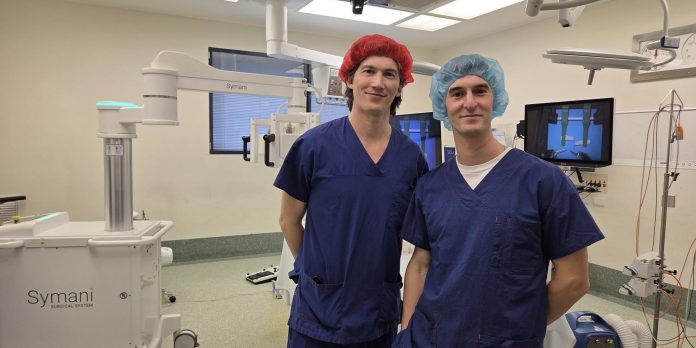Dual robotic surgery systems achieve a historic throat tumour removal, marking a leap in precision and patient care
In a world-first procedure, two advanced robotic surgery systems, da Vinci and Symani, worked together to remove a throat tumour, preserving the patient’s voice and ability to eat. This groundbreaking surgery marks a significant leap in robotic precision and surgical innovation.
St Vincent’s Hospital is Australia’s largest not-for-profit provider of health and aged care services, and is now home to a world-first procedure using two separate advanced robotic surgery systems.
Preserving the ability to speak using robotic surgery
Professor Ben Dixon, Director of ENT/Head and Neck Surgery, and Ed Morrison, Plastics and Reconstructive Surgeon, combined the da Vinci robot with the Symani robotic surgery system to successfully operate on a 27-year-old man named Jordan who had a sarcoma in his throat, just above his voice box.
Medical professionals initially recommended a laryngectomy, permanently removing Jordan’s voice box. However, using the two robotic surgery tools, the surgeons were able to keep Jordan’s larynx intact successfully. The tumour was removed entirely, and Jordan maintains his ability to speak and will require no further treatment.
Professor Dixon used the da Vinci robot to make precise internal throat incisions to remove the tumour, whilst limiting any disruption to the tongue, jaw, and larynx. Following the tumour removal, Dr Morrison used the Symani robot to meticulously repair vessels less than 1-1.5mm in diameter. He used transplanted tissues from the thigh, and a multi-layered closure of the hypopharynx was achieved, with resuspension of the larynx, ensuring near-normal speech and swallowing for Jordan.
Da Vinci Robot and the Symani Robotic system join forces to make history
The da Vinci surgical system is a revolutionary advancement in the field of minimally invasive surgery, allowing surgeons to perform complex procedures with enhanced precision and control. This robotic surgery system provides surgeons with a three-dimensional, high-definition view of the surgical site, significantly improving their visual field compared to traditional methods. The robotic arms are designed to mimic human hand movements, translating the surgeon’s hand motions into small, precise actions within the patient’s body.
By utilising the da Vinci robot, surgeons can navigate delicate anatomical structures with greater stability, which is crucial for minimising potential damage to surrounding tissues. The advantages of this approach include reduced scarring due to smaller incisions, as well as improved recovery outcomes; patients often experience less pain, quicker healing times, and reduced risk of infection.
The Symani robot, on the other hand, is designed for microsurgery. It enables surgeons to operate on microscopic structures, such as nerves and blood vessels, with superhuman precision. It is inspired by the natural motion of the human wrist and can mimic movements by surgeons operating the controllers on a smaller scale.
St Vincent’s Hospital is the first hospital in Australia to utilise the Symani and is employed in the newly created Clinical Microsurgery Robotic Unit based at the hospital. The Symani is currently being used for breast reconstruction, sarcoma, and head and neck cancer reconstruction surgery, but there is a promising potential for broader application in other surgical procedures. One of the standout features of the Symani is its ability to reduce surgeon fatigue. By optimising the surgical process and enhancing operational efficiency, surgeons can focus more on the intricacies of the procedure rather than the physical demands that often accompany traditional surgical methods.











